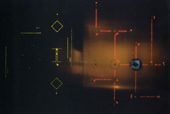
Concept Drawing: Ecosphere, 1996

Polykinetos, 1997
Like Chryssa and Athena Tacha, Electrus (a.k.a. Babis Vekris) belongs to a generation of Greek artists who emigrated from Greece when they were adults, and, like them, he became interested in technology early on. "I have always been curious as to how things work." He was born near Tripolis in 1950, one year after the Greek civil war ended.
There was a lot of guerrilla war there, up in the mountains. There were lots of broken weapons lying around. My first strong visual impression was a Volkswagen Beetle-I was five or six years old. It was a very memorable shape. Also its sound was a little bit rough because it did not have an air-cooling system.
In Athens he studied architecture ("I think if I weren't an artist, I would be an architect"), sculpture, and some electronics, but says that in electronics he is self taught.
In 1979, he left Greece and arrived in New York to study at the New York Studio School for three years: drawing, painting, sculpture, and art history-an intensive course of study that he continued for another year on a Ford Foundation grant.
Electrus is a kinetic artist who works with electronic devices, light-producing mechanisms, counting gadgets, and other contraptions, incorporating these elements into steel panels or installations of sculpture. He often works with spherical forms that represent the cosmos and planetary forces in relation to human activities, as in his Ecosphere (1996). When a work by Electrus is activated by turning on a switch, the action begins: lights blink on and off, and the various pieces of equipment perform their clockworklike activities-but it deliberately lacks a purpose or function.
Electrus is inspired by the artists of the American machine age (particularly Jean Xceron), but his outlook is thoroughly postmodern in that the allure of technology for him does not arise from an exaltation of the machine as an imperative of progress, as it did for the modernists. Instead, he is intrigued by machinery and electronics in and of themselves-and by the limitless variations that he can create through the perpetuation of various mechanical and electronic activities.